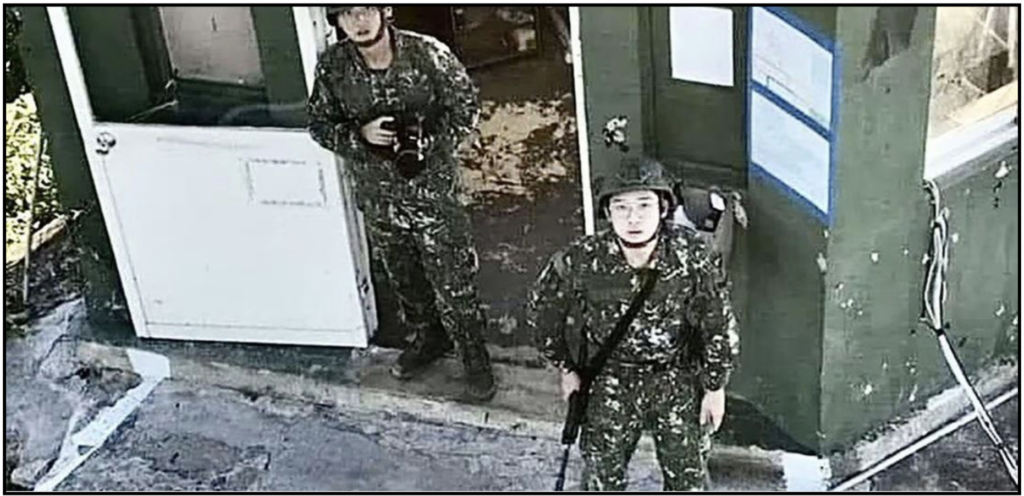On October 5, Taiwan Defense Minister Chiu Kuo-cheng (邱國正) made a remarkable statement regarding a change in Taiwanese defense policy: “In the past, we said we won’t be the first to strike, which meant we won’t do it without them firing artillery shells or missiles, et cetera, first… But now the definition has obviously changed, as China [has] used means like drones. So we have adjusted, and will view any crossing of aircraft or vessels as a first strike” (“空器實體飛越領空,就算第一擊”).
This implies a significant rethinking of the Taiwan military’s rules of engagement (ROEs), and is all the more extraordinary given the Taiwan national security establishment’s well-known aversion to risk. This risk aversion arises from both bureaucratic inertia and strategic concern that being seen as the aggressor would compromise international (primarily, the United States) support in a war for national survival. It is not for nothing that Taiwan President Tsai Ing-wen (蔡英文) has repeatedly underlined that Taiwan “will not act rashly when we have support” (“得到支持不冒進”). Operationally, this risk aversion has translated to gray zone responses that are symmetrical in nature and hampered by restrictive ROEs. In an all-out invasion scenario, such restrictive ROEs are even worse for the defender: by slowing down decision-making, they further enhance the aggressor’s implicit first-mover advantages.
In this article, I identify the primary drivers for such a reevaluation of Taiwan’s ROEs. Moreover, there are significant implications to this change for Taiwan’s defense and deterrence strategy, which if fully capitalized upon can undercut People’s Liberation Army (PLA) advantages in both gray zone warfare as well as a full-scale invasion scenario.
Gray Zone Backlash
For a number of years, the PRC has targeted Taiwan with an escalating campaign of gray zone warfare, defined as the integration of coercive military power as a function of political warfare. This escalation started quantitatively, and then qualitatively. Taking the air domain as an example, the PRC has horizontally and vertically escalated a campaign of incursions into Taiwan’s Air Defense Identification Zone (ADIZ) and across the Taiwan Strait “median line.” Incursions into Taiwan’s ADIZ began around 2016-2017. Starting in 2020, however, the number of incursions spiked to 380. The sophistication of the PLA “aircraft packages” utilized also increased: from a few fighters to high numbers of fighters, bombers, early warning, anti-submarine, and electronic warfare aircraft in multiple groupings, often taking the form of night-time incursions. This escalation of numbers and sophistication is quite similar to what the PLA did against Japan from 2013 to 2020, only replicated on a significantly faster timeframe given increased PLA experience and facilities. Now, the PLA is seeking to develop the capacity to execute these attrition-style missions against Japan and Taiwan at the same time.
The second type of incursion, across the Taiwan Strait “median line,” was previously reserved for making a specific political point, with only four median line incursions from 1954 to 2020. Both sides observed an “unspoken understanding” that the unofficial aerial boundary would be observed. However, following US Under Secretary of State Keith Krach’s visit to Taipei in September 2020, the PRC chose to launch dozens of aircraft across the median line over a two-day period, with over 40 incursions recorded. Then, following the visit of US Speaker of the House Nancy Pelosi to Taipei in August 2022, the PRC erased this unspoken understanding, with over 90 incursions across the median line since the visit. Finally, in August 2022, the PRC began utilizing unmanned aerial vehicles (UAVs) in the vicinity of Kinmen (金門) and Dongyin (東引) Islands, in Taiwan’s ADIZ, and across the median line. Put together, these changes indicate a significant shift in how the PRC conducts political signaling and gray zone warfare.
First, the symbolic deterrence of sending a few fighters into Taiwan’s ADIZ is increasingly being replaced by combat credible groupings of fighters, bombers, and reconnaissance and electronic warfare aircraft. The PLA is increasingly fusing deterrence and operational warfighting as a concept, practicing more complex coordination and maneuvers in the gray zone that will also have applicability in a full scale invasion. Second, predictability and the “unspoken understanding” is being replaced by unpredictability. The “median line” has been erased as a method of signaling PRC displeasure. The PRC is now accepting a greater risk of unforeseen consequences and accidents in order to increase coercion. Third, UAVs dramatically increase the ability for the PLA to engage in deniable, salami-slicing tactics, and to do so in a far more sustainable way than through the use of manned aircraft. The collapse of the “median line” as an unspoken barrier means that PRC UAVs will push towards Taiwan’s territorial waters/airspace (defined as within 12 nautical miles of Taiwan’s shores) as the next frontier of gray zone warfare.
The first indication that Taiwan was reevaluating its risk calculus came as a result of PRC UAV harassment of Taiwan garrison troops on Erdan Island (二膽島) near Kinmen on August 16. Footage of the harassment and the Taiwanese military response (which included rock throwing) was featured heavily in both PRC social and official media. This was particularly notable as this was a melding of gray zone activity with PRC propaganda, meant to publicly humiliate the Tsai Administration. Plausible deniability of state involvement was maintained, as the UAV model was identified to be civilian, although the ownership of the UAVs remain unknown.

(Source: South China Morning Post)
Taiwan’s response to the mockery was two-fold. First, in late August the military outlined a four-step response to future UAV overflights: firing warning flares, reporting the incursion, expelling the drone, and ultimately shooting it down. This was further backed by a presidential order to “adopt necessary and strong countermeasures” (“採取必要且強烈的反制措施”). This ROE was tested less than a week after the announcement, with an incident near Lion Islet (獅嶼). Second, the Ministry of National Defense (國防部) announced the priority deployment of anti-drone weapons, particularly to Taiwan’s outlying islands. These weapons will likely include anti-drone jamming guns and a remote drone-based defense system.
While these changes only deal with one system, the overall context of this attrition-style gray zone warfare has led the MND to consider broader changes, as outlined by Minister Chiu’s statements on redefined first strike. Unlike the UAV-specific ROEs, the extent to which that statement has resulted in changed operational orders is currently unknown. However, it is possible to project potential implications.
The Implications of a Rethink
It is important to note the Taiwanese actions that may now be taken as a result of the redefinition. As a start, this would provide the military greater authority and leeway to push down a decision to use force (either lethal or non-lethal). Instead of the office of the president or other senior-level national security staff first needing to be informed of a gray zone action and then directing an order to take countermeasures, such an order may instead come from a mid-level officer, such as a lieutenant colonel or a colonel. By itself, this would drastically speed up decision and reaction cycles.
Moreover, by moving the response decision to a lower command level, the type of action is now more unpredictable and can be more operational in nature. Current responses to gray zone activity are relatively set. As an example, manned aircraft incursions are usually met with manned intercepts (although this has been changing as increased operational costs have forced Taiwan to look at other responses, like tracking via air defense systems). Other salami-slicing tactics that push PRC military assets closer and closer to Taiwanese territorial waters or airspace, such as the use of sand dredgers around Matsu, instinctively count on Taiwanese risk-aversion or delayed decision-making to lower their own risk.
By complicating the risk calculations of the PRC, Taiwan can reduce its own operational risk. The PRC response to the September 1 shootdown of a civilian drone, for instance, was to announce restrictions and further regulations on civilian drone operations. On a larger scale, Taiwan could also put together its own combat-credible aircraft packages to cross over the median line at unpredictable intervals, as a reminder that eliminating the median line as an unspoken understanding will not only impose costs on Taiwan alone.
Finally, by moving away from a predictable, politically symbolic response model, Taiwan and the US can and should begin discussion of acceptable operational response parameters for both gray zone actions as well as a full-scale invasion. For instance, which actions could Taiwan take in the gray zone that would be unpredictable, while still maintaining perceptions on the international stage that they represented a mature, level-headed response? What level of indications and warning for a full-scale invasion would the US and Taiwan both accept as a PRC first strike that would fully justify a Taiwanese kinetic response or mobilization? If Taiwan leaders have full confidence that their self-defensive actions will have the support of the US and the international community, then Taiwan will be empowered to take countermeasures earlier in a crisis—and thereby reduce PRC first-mover advantages.
Conclusion
The PRC’s escalation of gray zone warfare has transformed the strategic and operational landscape for Taiwan. The PRC wishes to impose unpredictable, constant coercion, moving away from symbolic deterrence to melding warfighting with deterrence. Taiwan’s redefinition of first strike is an excellent first step to imposing unpredictability of its own, and allows for different methods of gray zone response that will also better position Taiwan to defend against a full-scale invasion.
The main point: The PRC’s rapid escalation of gray zone warfare against Taiwan has resulted in the breaking of unspoken norms. Taiwan’s redefinition of what constitutes a PRC first strike opens the way to a broader rethinking of response options—to include faster, more unpredictable responses as a method of re-imposing deterrence.



